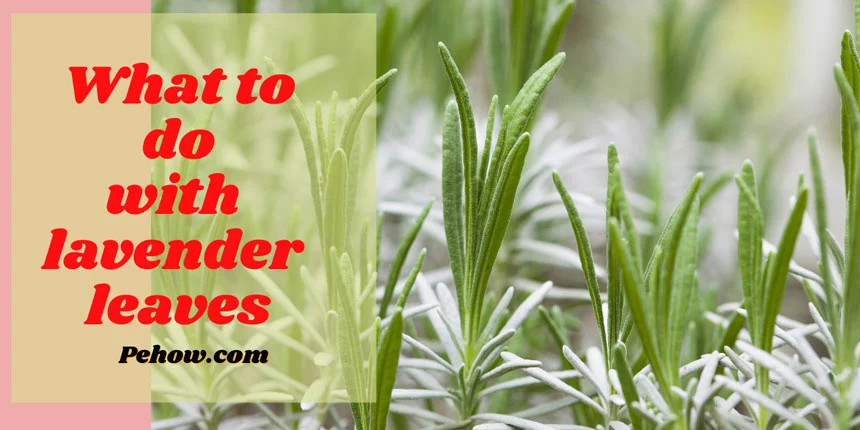I mostly spend time on forums when I’m free. A few days ago, I noticed lavender leaf questions coming up more and more. I thought I’d post about what to do with them since I have some experience.
If you’re curious about lavender leaves, you’re not alone. Many wonder what to do with them since they don’t seem as useful as the flowers.
Lavender leaves are a great addition to any herb garden. They have a strong scent and can be used in many different ways. Keep reading to learn more about lavender leaves and what to do with them.
10 Uses of Lavender Leaves
Lavender leaves can be used in a variety of ways around the homestead. Here are 10 uses for lavender leaves that you may not have thought of!
Don’t worry; I have confirmed 10 uses for lavender leaves to take you one step further in your love for this fragrant herb!
1. Lavender Oil
I started with lavender leaf oil because it is one of the most popular ways to use lavender leaves. You can make your lavender oil by following this tutorial.
To make lavender oil, you will need the following:
- A glass jar with a lid
- 1 cup of fresh lavender leaves
- Extra virgin olive oil or fractionated coconut oil
Instructions:
1. Fill the jar about three-quarters of the way full with fresh lavender leaves.
2. Pour enough olive oil or fractionated coconut oil to submerge the leaves fully. Using fractionated coconut oil, you may need to heat it slightly so it becomes liquid.
3. Put on the lid and shake well to combine.
4. Store in a cool, dark place for two to four weeks, shaking occasionally.
5. Strain the oil through a fine mesh strainer into another glass jar or bottle. Discard the leaves.
6. Label and store your lavender oil in a cool, dark place until ready to use.
2. Headache Salve
There is a lot of research has been conducted on the use of lavender for headaches. A study published in Researchgate in 2012 found that “Lavender Essential Oil in the Treatment of Migraine Headache: A Placebo-Controlled Clinical Trial“.
Lavender oil can be used to make a headache salve. To make the salve, you will need:
- 1/4 cup of lavender oil
- 1/2 cup of beeswax
- 1/2 cup of olive oil
Instructions:
1. Combine lavender, beeswax, and olive oil in a double boiler.
2. Heat the mixture until the beeswax is melted.
3. Pour the mixture into a jar and allow it to cool.
4. Apply the salve to your forehead and temples when you have a headache.
For additional headache relief, you can add other essential oils to the salve, such as peppermint or eucalyptus.
3. Bug Bite Itchy Sticks
Bug Bite Itchy Sticks is an all-natural remedy for bug bites and stings. The lavender leaves in the sticks help soothe the itch and inflammation, and the peppermint oil helps keep the bugs away. The sticks are easy to use–just rub them on the affected area.
They’re also great for preventing bites and stings in the first place. Keep a few in your purse or backpack, and you’ll never have to worry about bug bites again.
Lavender oil is also great for keeping bugs away. If you’re going to be outside for a while, rub some lavender oil on your skin. The bugs will stay away, and you’ll smell great too!
Lavender leaves can also make a cooling compress for bug bites and stings. Just steep some lavender leaves in boiling water for a few minutes, then let the mixture cool. Apply it to the affected area with a clean cloth, and you’ll instantly feel relief from the itchiness and pain.
4. Bath Soak
When it comes to lavender leaves, there are a few different things you can do with them. One option is to use them as a bath soak. This is a great way to relax and unwind after a long day. To do this, add a handful of lavender leaves to your bathtub and enjoy the aromatic steam.
5. Pillow Spray
If you’re looking for a way to relax and unwind after a long day, consider using a lavender pillow spray. Lavender is known for its relaxing properties, and the scent of lavender can help you get a good night’s sleep.
To make a lavender pillow spray, you will need the following:
- 1/4 cup of lavender oil
- 1/2 cup of distilled water
- A small spray bottle
Instructions:
1. Combine the lavender oil and distilled water in a small spray bottle. Shake well to combine.
2. Spray the mixture on your pillow before bedtime. Enjoy the relaxing scent of lavender as you drift off to sleep.
For additional relaxation, you can also add other essential oils to the spray, such as chamomile or ylang-ylang.
6. Lavender Air Freshener
Lavender leaves can be used to make a natural air freshener. You will need a jar with a lid, lavender leaves, water, and vodka to do this. The vodka is optional, but it will help the leaves to keep their color.
Fill the jar about two-thirds of the way with lavender leaves. Pour in water until the leaves are covered, then add vodka. Put on the lid and shake the jar to mix everything together.
Store the jar in a cool, dark place for two weeks. Shake it every day or so. After two weeks, strain out the leaves and discard them. Pour the liquid into a spray bottle and use it as needed.
7. Use as a natural insect repellent
Lavender leaves can be used as a natural insect repellent. A study published in the Journal of Agricultural and Food Chemistry found that lavender oil effectively repels mosquitoes. In addition, a study published in the Journal of Vector Ecology found lavender oil effectively repels biting flies.
To use lavender leaves as an insect repellent, simply crush a few leaves and rub them on your skin. You can also add a few drops of lavender oil to a diffuser to help keep insects away.
8. Cooking with Lavender Leaves
Lavender leaves can be used in cooking just like flowers. They have a slightly sweet, floral flavor that can be used to add flavor to food or tea. Lavender leaves can also be dried and stored for later use.
Here are some tips on how to use lavender leaves in cooking:
- Add a few lavender leaves to boiling water when making tea.
- Toss some lavender leaves into a salad for a light, floral flavor.
- Add dried lavender leaves to homemade potpourri.
- Use lavender leaves to flavor chicken, lamb, or fish dishes.
- Make the lavender sugar by grinding dried lavender leaves with sugar in a food processor. Use this sugar to sweeten tea or sprinkle it on baked goods.
As you can see, there are many ways to use lavender leaves in cooking. Get creative and experiment with different recipes to find the perfect way to use this fragrant herb in your cooking.
9. Lavender In Food
Lavender is a versatile herb that can be used in both savory and sweet dishes. For savory dishes, lavender can be added to chicken, fish rubs, or sauces. It can also be used to make herbal tea.
Lavender tea is a great way to relax and unwind after a long day. For sweet dishes, lavender can be used as an ingredient in cookies, cakes, and other desserts. It has a wonderful floral flavor that pairs well with the sweetness.
10. Green Lavender Bath Soak
Lavender leaves can be used in a bath soak to help relax the body and mind. The leaves can be dried and crushed or used fresh.
Add 1-2 tablespoons of lavender leaves to a bathtub filled with warm water. Soak for 10-15 minutes, then rinse off. The leaves can also be added to a bath salt mixture.
What are lavender leaves good for?
Lavender leaves are great for soothing skin irritations and burns. They can also be used to make refreshing tea. To make lavender tea, steep a few lavender leaves in hot water for 5-10 minutes. You can also add a bit of honey or lemon to taste. Lavender leaves can also be used in potpourri or sachets.
Lavender leaves add beauty to the plant but don’t have the same fragrant oil as the flowers. They can be used in cooking, but bittersweet flavors may result. If you want to use them for culinary purposes, it’s best to dry them first.
Lavender leaves are also a beautiful addition to any garden. When planting lavender, leave some leaves on the plant so it will continue to thrive.
Can other animals eat lavender leaves?
Lavender leaves are edible for both humans and animals. They are a good source of vitamins A, C, and E and minerals such as potassium, magnesium, and calcium. Lavender leaves can be chopped and added to salads or brewed into tea. They have a sweet, floral flavor that is refreshing and soothing.
Livestock can also eat lavender leaves, which helps to improve their digestion. Lavender leaves are safe for dogs and cats to consume but should be given in moderation due to their strong flavor.
Can you drink fresh lavender leaves?
Lavender leaves are safe to consume in small quantities but should not be consumed in large quantities or regularly. Some people may experience an upset stomach after consuming lavender leaves, so it is best to eat them in moderation.
Lavender leaves can be used to make tea, added to baked goods, or thrown into a salad for a subtle flavor. When using lavender leaves in cooking, it is best to chop them up so that their strong flavor is not overpowering.
The Summary
Lavender leaves are versatile and fragrant ingredients that can be used in many ways. From tea to skincare, there are many uses for this herb. When using lavender leaves, moderate them so you don’t experience any negative side effects.
Remember that there are many more uses besides the 10 uses I mentioned in this article. Get creative and experiment with different recipes to find the perfect way to use lavender leaves in your cooking.
I hope this article helped teach you what to do with lavender leaves. If you have any questions, feel free to leave a comment below. And if you want more tips on how to use lavender, be sure to check out my other articles.
What are you thinking about including in your next lavender-infused dish? Let me know in the comments below!



